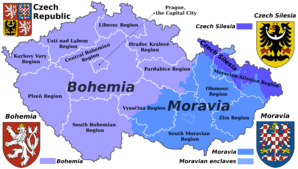Czech Republic
- Acèh
- Адыгэбзэ
- Адыгабзэ
- Afrikaans
- Alemannisch
- አማርኛ
- Anarâškielâ
- अंगिका
- Ænglisc
- Аԥсшәа
- العربية
- Aragonés
- ܐܪܡܝܐ
- Արեւմտահայերէն
- Armãneashti
- Arpetan
- অসমীয়া
- Asturianu
- अवधी
- Avañe'ẽ
- Авар
- Aymar aru
- Azərbaycanca
- تۆرکجه
- Basa Bali
- বাংলা
- Bân-lâm-gú
- Basa Banyumasan
- Башҡортса
- Беларуская
- Беларуская (тарашкевіца)
- भोजपुरी
- Bikol Central
- Bislama
- Български
- Boarisch
- བོད་ཡིག
- Bosanski
- Brezhoneg
- Буряад
- Català
- Чӑвашла
- Cebuano
- Čeština
- Chamoru
- Chavacano de Zamboanga
- Chi-Chewa
- ChiShona
- ChiTumbuka
- Corsu
- Cymraeg
- Dansk
- الدارجة
- Davvisámegiella
- Deitsch
- Deutsch
- ދިވެހިބަސް
- Diné bizaad
- Dolnoserbski
- डोटेली
- ཇོང་ཁ
- Eesti
- Ελληνικά
- Эрзянь
- Español
- Esperanto
- Estremeñu
- Euskara
- Eʋegbe
- فارسی
- Fiji Hindi
- Føroyskt
- Français
- Frysk
- Fulfulde
- Furlan
- Gaeilge
- Gaelg
- Gagauz
- Gàidhlig
- Galego
- گیلکی
- ગુજરાતી
- 𐌲𐌿𐍄𐌹𐍃𐌺
- गोंयची कोंकणी / Gõychi Konknni
- 客家語/Hak-kâ-ngî
- Хальмг
- 한국어
- Hausa
- Hawaiʻi
- Հայերեն
- हिन्दी
- Hornjoserbsce
- Hrvatski
- Ido
- Igbo
- Ilokano
- বিষ্ণুপ্রিয়া মণিপুরী
- Bahasa Indonesia
- Interlingua
- Interlingue
- Iñupiatun
- Ирон
- IsiZulu
- Íslenska
- Italiano
- עברית
- Jawa
- Kabɩyɛ
- ಕನ್ನಡ
- Kapampangan
- Къарачай-малкъар
- ქართული
- Kaszëbsczi
- Қазақша
- Kernowek
- Ikinyarwanda
- Kiswahili
- Коми
- Kongo
- Kotava
- Kreyòl ayisyen
- Kriyòl gwiyannen
- Kurdî
- Кыргызча
- Ladin
- Ladino
- Лакку
- ລາວ
- Latgaļu
- Latina
- Latviešu
- Lëtzebuergesch
- Лезги
- Lietuvių
- Ligure
- Limburgs
- Lingála
- Lingua Franca Nova
- Livvinkarjala
- La .lojban.
- Lombard
- Magyar
- Madhurâ
- Македонски
- Malagasy
- മലയാളം
- Malti
- Māori
- मराठी
- მარგალური
- مصرى
- مازِرونی
- Bahasa Melayu
- ꯃꯤꯇꯩ ꯂꯣꯟ
- Minangkabau
- 閩東語 / Mìng-dĕ̤ng-ngṳ̄
- Mirandés
- Мокшень
- Монгол
- မြန်မာဘာသာ
- Nederlands
- Nedersaksies
- नेपाली
- नेपाल भाषा
- 日本語
- Napulitano
- Нохчийн
- Nordfriisk
- Norfuk / Pitkern
- Norsk bokmål
- Norsk nynorsk
- Nouormand
- Novial
- Occitan
- Олык марий
- ଓଡ଼ିଆ
- Oromoo
- Oʻzbekcha / ўзбекча
- ਪੰਜਾਬੀ
- पालि
- Pälzisch
- Pangasinan
- Pangcah
- پنجابی
- Papiamentu
- پښتو
- Patois
- Перем коми
- ភាសាខ្មែរ
- Picard
- Piemontèis
- Tok Pisin
- Plattdüütsch
- Polski
- Ποντιακά
- Português
- Qaraqalpaqsha
- Qırımtatarca
- Reo tahiti
- Română
- Romani čhib
- Rumantsch
- Runa Simi
- Русиньскый
- Русский
- Саха тыла
- Sakizaya
- Gagana Samoa
- संस्कृतम्
- ᱥᱟᱱᱛᱟᱲᱤ
- Sardu
- Scots
- Seediq
- Seeltersk
- Sesotho
- Shqip
- Sicilianu
- සිංහල
- Simple English
- سنڌي
- SiSwati
- Slovenčina
- Slovenščina
- Словѣньскъ / ⰔⰎⰑⰂⰡⰐⰠⰔⰍⰟ
- Ślůnski
- Soomaaliga
- کوردی
- Sranantongo
- Српски / srpski
- Srpskohrvatski / српскохрватски
- Sunda
- Suomi
- Svenska
- Tagalog
- தமிழ்
- Taclḥit
- Taqbaylit
- Tarandíne
- Татарча / tatarça
- ၽႃႇသႃႇတႆး
- Tayal
- తెలుగు
- Tetun
- ไทย
- Тоҷикӣ
- Lea faka-Tonga
- ᏣᎳᎩ
- Tsetsêhestâhese
- Türkçe
- Türkmençe
- Tyap
- Удмурт
- Українська
- اردو
- ئۇيغۇرچە / Uyghurche
- Vahcuengh
- Vèneto
- Vepsän kel’
- Tiếng Việt
- Volapük
- Võro
- Walon
- 文言
- West-Vlams
- Winaray
- Wolof
- 吴语
- Xitsonga
- ייִדיש
- Yorùbá
- 粵語
- Zazaki
- Zeêuws
- Žemaitėška
- 中文
- Tolışi
Czech Republic Česká republika (Czech) | |
|---|---|
| Motto: | |
| Religion (2021)[3] |
other |
| Demonym(s) | Czech |
| Government | Unitary parliamentary republic |
| Petr Pavel | |
| Petr Fiala | |
| Legislature | Parliament |
| Senate | |
| Chamber of Deputies | |
| Establishment | |
| c. 870 | |
| 1198 | |
| 28 October 1918 | |
| 1 January 1993 | |
| Area | |
• Total | 78,871 km2 (30,452 sq mi)[4] (115th) |
• Water (%) | 2.16 (as of 2022)[4] |
| Population | |
• 2023 estimate | |
• 2021 census | |
• Density | 133/km2 (344.5/sq mi) (91st) |
| GDP (PPP) | 2023 estimate |
• Total | |
• Per capita | |
| GDP (nominal) | 2023 estimate |
• Total | |
• Per capita | |
| Gini (2020) | low |
| HDI (2022) | very high (32nd) |
| Currency | Czech koruna (CZK) |
| Time zone | UTC+1 (CET) |
• Summer (DST) | UTC+2 (CEST) |
| Date format | d. m. yyyy |
| Driving side | right |
| Calling code | +420[a] |
| ISO 3166 code | CZ |
| Internet TLD | .cz[b] |
The Czech Republic,[c][12] also known as Czechia,[d][13] is a landlocked country in Central Europe. Historically known as Bohemia,[14] it is bordered by Austria to the south, Germany to the west, Poland to the northeast, and Slovakia to the southeast.[15] The Czech Republic has a hilly landscape that covers an area of 78,871 square kilometers (30,452 sq mi) with a mostly temperate continental and oceanic climate. The capital and largest city is Prague; other major cities and urban areas include Brno, Ostrava, Plzeň and Liberec.
The Duchy of Bohemia was founded in the late 9th century under Great Moravia. It was formally recognized as an Imperial State of the Holy Roman Empire in 1002 and became a kingdom in 1198.[16][17] Following the Battle of Mohács in 1526, all of the Crown lands of Bohemia were gradually integrated into the Habsburg monarchy. Nearly a hundred years later, the Protestant Bohemian Revolt led to the Thirty Years' War. After the Battle of White Mountain, the Habsburgs consolidated their rule. With the dissolution of the Holy Roman Empire in 1806, the Crown lands became part of the Austrian Empire.
In the 19th century, the Czech lands became more industrialized, and in 1918 most of it became part of the First Czechoslovak Republic following the collapse of Austria-Hungary after World War I.[18] Czechoslovakia was the only country in Central and Eastern Europe to remain a parliamentary democracy during the entirety of the interwar period.[19] After the Munich Agreement in 1938, Nazi Germany systematically took control over the Czech lands.
Czechoslovakia was restored in 1945 and three years later became an Eastern Bloc communist state following a coup d'état in 1948. Attempts to liberalize the government and economy were suppressed by a Soviet-led invasion of the country during the Prague Spring in 1968. In November 1989, the Velvet Revolution ended communist rule in the country and restored democracy. On 31 December 1992, Czechoslovakia was peacefully dissolved, with its constituent states becoming the independent states of the Czech Republic and Slovakia.
The Czech Republic is a unitary parliamentary republic and developed country with an advanced, high-income social market economy. It is a welfare state with a European social model, universal health care and free-tuition university education. It ranks 32nd in the Human Development Index. The Czech Republic is a member of the United Nations, NATO, the European Union, the OECD, the OSCE, the Council of Europe and the Visegrád Group.
Etymology
The traditional English name "Bohemia" derives from
The country has been traditionally divided into three lands, namely Bohemia (Čechy) in the west, Moravia (Morava) in the east, and Czech Silesia (Slezsko; the smaller, south-eastern part of historical Silesia, most of which is located within modern Poland) in the northeast.[24] Known as the lands of the Bohemian Crown since the 14th century, a number of other names for the country have been used, including Czech/Bohemian lands, Bohemian Crown, Czechia, [25] and the lands of the Crown of Saint Wenceslaus. When the country regained its independence after the dissolution of the Austro-Hungarian empire in 1918, the new name of Czechoslovakia was coined to reflect the union of the Czech and Slovak nations within one country.[26]
After Czechoslovakia dissolved on the last day of 1992, Česko was adopted as the Czech short name for the new state and the Ministry of Foreign Affairs of the Czech Republic recommended Czechia for the English-language equivalent.[27] This form was not widely adopted at the time, leading to the long name Czech Republic being used in English in nearly all circumstances. The Czech government directed use of Czechia as the official English short name in 2016.[28] The short name has been listed by the United Nations[29] and is used by other organizations such as the European Union,[30] NATO,[31] the CIA,[32] Google Maps,[33] and the European Broadcasting Union.[34] In 2022, the American AP Stylebook stated in its entry on the country that "Czechia, the Czech Republic. Both are acceptable. The shorter name Czechia is preferred by the Czech government. If using Czechia, clarify in the story that the country is more widely known in English as the Czech Republic."[35]
History
Prehistory
Right: the stone head of a Celt is among the archaeological collections of the National Museum.[36]
Archaeologists have found evidence of prehistoric human settlements in the area, dating back to the Paleolithic era.[citation needed]
In the classical era, as a result of the 3rd century BC Celtic migrations, Bohemia became associated with the Boii.[37] The Boii founded an oppidum near the site of modern Prague.[38] Later in the 1st century, the Germanic tribes of the Marcomanni and Quadi settled there.[39]
Slavs from the Black Sea–Carpathian region settled in the area (their migration was pushed by an invasion of peoples from Siberia and Eastern Europe into their area:[40] Huns, Avars, Bulgars and Magyars).[41] In the sixth century, the Huns had moved westwards into Bohemia, Moravia, and some of present-day Austria and Germany.[41]
During the 7th century, the Frankish merchant Samo, supporting the Slavs fighting against nearby settled Avars,[42] became the ruler of the first documented Slavic state in Central Europe, Samo's Empire. The principality of Great Moravia, controlled by Moymir dynasty, arose in the 8th century.[43] It reached its zenith in the 9th (during the reign of Svatopluk I of Moravia), holding off the influence of the Franks. Great Moravia was Christianized, with a role being played by the Byzantine mission of Cyril and Methodius. They codified the Old Church Slavonic language, the first literary and liturgical language of the Slavs, and the Glagolitic script.[44]
Bohemia
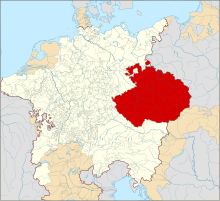
The Duchy of Bohemia emerged in the late 9th century when it was unified by the Přemyslid dynasty. Bohemia was from 1002 until 1806 an Imperial Estate of the Holy Roman Empire.[45]
In 1212, Přemysl Ottokar I extracted the Golden Bull of Sicily from the emperor, confirming Ottokar and his descendants' royal status; the Duchy of Bohemia was raised to a Kingdom.[46] German immigrants settled in the Bohemian periphery in the 13th century.[47] The Mongols in the invasion of Europe carried their raids into Moravia but were defensively defeated at Olomouc.[48]
After a series of dynastic wars, the House of Luxembourg gained the Bohemian throne.[49]
Efforts for a reform of the church in Bohemia started already in the late 14th century. Jan Hus' followers seceded from some practices of the Roman Church and in the Hussite Wars (1419–1434) defeated five crusades organized against them by Sigismund. During the next two centuries, 90% of the population in Bohemia and Moravia were considered Hussites. The pacifist thinker Petr Chelčický inspired the movement of the Moravian Brethren (by the middle of the 15th century) that completely separated from the Roman Catholic Church.[50]
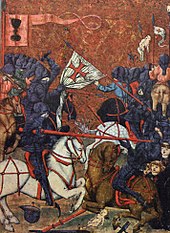
On 21 December 1421, Jan Žižka, a successful military commander and mercenary, led his group of forces in the Battle of Kutná Hora, resulting in a victory for the Hussites. He is honoured to this day as a national hero.
After 1526 Bohemia came increasingly under Habsburg control as the Habsburgs became first the elected and then in 1627 the hereditary rulers of Bohemia. Between 1583 and 1611 Prague was the official seat of the Holy Roman Emperor Rudolf II and his court.
The Defenestration of Prague and subsequent revolt against the Habsburgs in 1618 marked the start of the Thirty Years' War. In 1620, the rebellion in Bohemia was crushed at the Battle of White Mountain and the ties between Bohemia and the Habsburgs' hereditary lands in Austria were strengthened. The leaders of the Bohemian Revolt were executed in 1621. The nobility and the middle class Protestants had to either convert to Catholicism or leave the country.[51]
The following era of 1620 to the late 18th century became known as the "Dark Age". During the Thirty Years' War, the population of the Czech lands declined by a third through the expulsion of Czech Protestants as well as due to the war, disease and famine.[52] The Habsburgs prohibited all Christian confessions other than Catholicism.[53] The flowering of Baroque culture shows the ambiguity of this historical period. Ottoman Turks and Tatars invaded Moravia in 1663.[54] In 1679–1680 the Czech lands faced the Great Plague of Vienna and an uprising of serfs.[55]

There were peasant uprisings influenced by famine.[56] Serfdom was abolished between 1781 and 1848. Several battles of the Napoleonic Wars took place on the current territory of the Czech Republic.
The end of the Holy Roman Empire in 1806 led to degradation of the political status of Bohemia which lost its position of an electorate of the Holy Roman Empire as well as its own political representation in the Imperial Diet.[57] Bohemian lands became part of the Austrian Empire. During the 18th and 19th century the Czech National Revival began its rise, with the purpose to revive Czech language, culture, and national identity. The Revolution of 1848 in Prague, striving for liberal reforms and autonomy of the Bohemian Crown within the Austrian Empire, was suppressed.[58]
It seemed that some concessions would be made also to Bohemia, but in the end, the Emperor Franz Joseph I affected a compromise with Hungary only. The Austro-Hungarian Compromise of 1867 and the never realized coronation of Franz Joseph as King of Bohemia led to a disappointment of some Czech politicians.[58] The Bohemian Crown lands became part of the so-called Cisleithania.
The Czech Social Democratic and progressive politicians started the fight for universal suffrage. The first elections under universal male suffrage were held in 1907.[59]
Czechoslovakia
The First Czechoslovak Republic comprised only 27% of the population of the former Austria-Hungary, but nearly 80% of the industry, which enabled it to compete with Western industrial states.[60] In 1929 compared to 1913, the gross domestic product increased by 52% and industrial production by 41%. In 1938 Czechoslovakia held 10th place in the world industrial production.[63] Czechoslovakia was the only country in Central and Eastern Europe to remain a liberal democracy throughout the entire interwar period.[64] Although the First Czechoslovak Republic was a unitary state, it provided certain rights to its minorities, the largest being Germans (23.6% in 1921), Hungarians (5.6%) and Ukrainians (3.5%).[65]

Western Czechoslovakia was
In the
Czech Republic
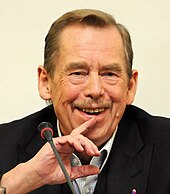
In November 1989, Czechoslovakia again became a liberal democracy through the Velvet Revolution. However, Slovak national aspirations strengthened (Hyphen War) and on 31 December 1992, the country peacefully split into the independent countries of the Czech Republic and Slovakia. Both countries went through economic reforms and privatizations, with the intention of creating a market economy, as they have been trying to do since 1990, when Czechs and Slovaks still shared the common state. This process was largely successful; in 2006 the Czech Republic was recognized by the World Bank as a "developed country",[71] and in 2009 the Human Development Index ranked it as a nation of "Very High Human Development".[72]
From 1991, the Czech Republic, originally as part of Czechoslovakia and since 1993 in its own right, has been a member of the
Until 2017, either the centre-left
In the
Geography

The Czech Republic lies mostly between latitudes 48° and 51° N and longitudes 12° and 19° E.
Water from the Czech Republic flows to three different seas: the
Phytogeographically, the Czech Republic belongs to the Central European province of the Circumboreal Region, within the Boreal Kingdom. According to the World Wide Fund for Nature, the territory of the Czech Republic can be subdivided into four ecoregions: the Western European broadleaf forests, Central European mixed forests, Pannonian mixed forests, and Carpathian montane conifer forests.[80]
There are four national parks in the Czech Republic. The oldest is Krkonoše National Park (Biosphere Reserve), and the others are Šumava National Park (Biosphere Reserve), Podyjí National Park, and Bohemian Switzerland.
The three historical lands of the Czech Republic (formerly some countries of the Bohemian Crown) correspond with the river basins of the Elbe and the Vltava basin for Bohemia, the Morava one for Moravia, and the Oder river basin for Czech Silesia (in terms of the Czech territory).
Climate

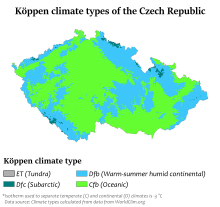
The Czech Republic has a temperate climate, situated in the transition zone between the oceanic and continental climate types, with warm summers and cold, cloudy and snowy winters. The temperature difference between summer and winter is due to the landlocked geographical position.[81]
Temperatures vary depending on the elevation. In general, at higher altitudes, the temperatures decrease and
At the highest peak of Sněžka (1,603 m or 5,259 ft), the average temperature is −0.4 °C (31 °F), whereas in the lowlands of the South Moravian Region, the average temperature is as high as 10 °C (50 °F). The country's capital, Prague, has a similar average temperature, although this is influenced by urban factors.
The coldest month is usually January, followed by February and December. During these months, there is snow in the mountains and sometimes in the cities and lowlands. During March, April, and May, the temperature usually increases, especially during April, when the temperature and weather tends to vary during the day. Spring is also characterized by higher water levels in the rivers, due to melting snow with occasional flooding.
The warmest month of the year is July, followed by August and June. On average, summer temperatures are about 20–30 °C (36–54 °F) higher than during winter. Summer is also characterized by rain and storms.
Autumn generally begins in September, which is still warm and dry. During October, temperatures usually fall below 15 °C (59 °F) or 10 °C (50 °F) and deciduous trees begin to shed their leaves. By the end of November, temperatures usually range around the freezing point.
The coldest temperature ever measured was in Litvínovice near České Budějovice in 1929, at −42.2 °C (−44.0 °F) and the hottest measured, was at 40.4 °C (104.7 °F) in Dobřichovice in 2012.[82]
Most rain falls during the summer. Sporadic rainfall is throughout the year (in Prague, the average number of days per month experiencing at least 0.1 mm (0.0039 in) of rain varies from 12 in September and October to 16 in November) but concentrated rainfall (days with more than 10 mm (0.39 in) per day) are more frequent in the months of May to August (average around two such days per month).[83] Severe thunderstorms, producing damaging straight-line winds, hail, and occasional tornadoes occur, especially during the summer period.[84][85]
Environment
As of 2020, the Czech Republic ranks as the 21st most environmentally conscious country in the world in
Government
The Czech Republic is a pluralist multi-party
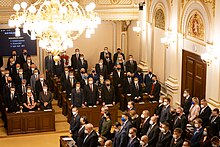
The president is a formal head of state with limited and specific powers, who appoints the prime minister, as well the other members of the cabinet on a proposal by the prime minister. From 1993 until 2012, the
| Office | Name | Party | Since |
|---|---|---|---|
| President | Petr Pavel | Independent | 9 March 2023 |
| President of the Senate | Miloš Vystrčil | ODS | 19 February 2020 |
| President of the Chamber of Deputies | Markéta Pekarová Adamová | TOP 09 | 10 November 2021 |
| Prime Minister | Petr Fiala | ODS | 28 November 2021 |
Law

The Czech Republic is a unitary state,[93] with a civil law system based on the continental type, rooted in Germanic legal culture. The basis of the legal system is the Constitution of the Czech Republic adopted in 1993.[94] The Penal Code is effective from 2010. A new Civil code became effective in 2014. The court system includes district, county, and supreme courts and is divided into civil, criminal, and administrative branches. The Czech judiciary has a triumvirate of supreme courts. The Constitutional Court consists of 15 constitutional judges and oversees violations of the Constitution by either the legislature or by the government.[94] The Supreme Court is formed of 67 judges and is the court of highest appeal for most legal cases heard in the Czech Republic. The Supreme Administrative Court decides on issues of procedural and administrative propriety. It also has jurisdiction over certain political matters, such as the formation and closure of political parties, jurisdictional boundaries between government entities, and the eligibility of persons to stand for public office.[94] The Supreme Court and the Supreme Administrative Court are both based in Brno, as is the Supreme Public Prosecutor's Office.[94]
Foreign relations
The Czech Republic has ranked as one of the safest or most peaceful countries for the past few decades.[95] It is a member of the United Nations, the European Union, NATO, OECD, Council of Europe and is an observer to the Organization of American States.[96] The embassies of most countries with diplomatic relations with the Czech Republic are located in Prague, while consulates are located across the country.
The Czech passport is

The
The Czech Republic has ties with
Czech officials have supported dissenters in Belarus, Moldova, Myanmar and Cuba.[105]
Famous Czech diplomats of the past included Jaroslav Lev of Rožmitál, Humprecht Jan Czernin, Count Philip Kinsky of Wchinitz and Tettau, Wenzel Anton, Prince of Kaunitz-Rietberg, Prince Karl Philipp Schwarzenberg, Alois Lexa von Aehrenthal, Ottokar Czernin, Edvard Beneš, Jan Masaryk, Jiří Hájek, Jiří Dienstbier, Michael Žantovský, Petr Kolář, Alexandr Vondra, Prince Karel Schwarzenberg and Petr Pavel.
Military
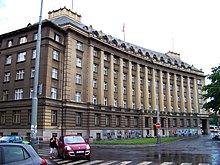
The Czech armed forces consist of the Czech Land Forces, the Czech Air Force and of specialized support units. The armed forces are managed by the Ministry of Defence. The President of the Czech Republic is Commander-in-chief of the armed forces. In 2004 the army transformed itself into a fully professional organization and compulsory military service was abolished. The country has been a member of NATO since 12 March 1999. Defence spending is approximately 1.28% of the GDP (2021).[106] The armed forces are charged with protecting the Czech Republic and its allies, promoting global security interests, and contributing to NATO.
Currently, as a member of NATO, the Czech military are participating in the
).The most famous Czech, and therefore Czechoslovak, soldiers and military leaders of the past were Ottokar II of Bohemia, John of Bohemia, Jan Žižka, Albrecht von Wallenstein, Karl Philipp, Prince of Schwarzenberg, Joseph Radetzky von Radetz, Josef Šnejdárek, Heliodor Píka, Ludvík Svoboda, Jan Kubiš, Jozef Gabčík, František Fajtl and Petr Pavel.
Human rights
Human rights in the Czech Republic are guaranteed by the

Prague is the seat of Radio Free Europe/Radio Liberty. Today, the station is based in Hagibor. At the beginning of the 1990s, Václav Havel personally invited her to Czechoslovakia.[112]
People of the same sex can enter into a "
The best-known Czech activists and supporters of human rights include Berta von Suttner, born in Prague, who won the Nobel Peace Prize for her pacifist struggle, philosopher and the first Czechoslovak president Tomáš Garrigue Masaryk, student Jan Palach, who set himself on fire in 1969 in protest against the Soviet occupation, Karel Schwarzenberg, who was chairman of the International Helsinki Committee for Human Rights between 1984 and 1990, Václav Havel, long-time dissident and later president, sociologist and dissident Jiřina Šiklová and Šimon Pánek, founder and director of the People in Need organization.
Administrative divisions
Since 2000, the Czech Republic has been divided into thirteen regions (Czech: kraje, singular kraj) and the capital city of Prague. Every region has its own elected regional assembly and a regional governor. In Prague, the assembly and presidential powers are executed by the city council and the mayor.
The older seventy-six districts (okresy, singular okres) including three "statutory cities" (without Prague, which had special status) lost most of their importance in 1999 in an administrative reform; they remain as territorial divisions and seats of various branches of state administration.[114]
The smallest administrative units are obce (municipalities). As of 2021, the Czech Republic is divided into 6,254 municipalities. Cities and towns are also municipalities. The capital city of Prague is a region and municipality at the same time.
Economy
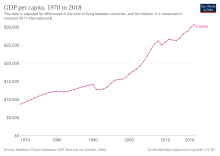
The Czech Republic has a
As of 2023[update], the country's
Industry

In 2018[update] the
(electric scooters).Škoda Transportation is the fourth largest tram producer in the world; nearly one third of all trams in the world come from Czech factories.[136] The Czech Republic is also the world's largest vinyl records manufacturer, with GZ Media producing about 6 million pieces annually in Loděnice.[137] Česká zbrojovka is among the ten largest firearms producers in the world and five who produce automatic weapons.[138]
In the food industry, Czech companies include Agrofert, Kofola and Hamé.
Energy

Production of Czech electricity exceeds consumption by about 10
The Czech Republic is reducing its dependence on highly polluting low-grade
Transportation infrastructure

As of 2020,[update] the road network in the Czech Republic is 55,768.3 kilometers (34,652.82 mi) long, out of which 1,276.4 km (793.1 mi) are motorways.[140] The speed limit is 50 km/h (31 mph) within towns, 90 km/h (56 mph) outside of towns and 130 km/h (81 mph) on motorways.[141]
The Czech Republic has one of the densest rail networks in the world. As of 2020,[update] the country has 9,542 kilometers (5,929 mi) of lines. Of that number, 3,236 km (2,011 mi) is electrified, 7,503 km (4,662 mi) are single-line tracks and 2,040 km (1,270 mi) are double and multiple-line tracks.[142] The length of tracks is 15,360 km (9,540 mi), out of which 6,917 km (4,298 mi) is electrified.[143]
České dráhy (the Czech Railways) is the main railway operator in the country, with about 180 million passengers carried yearly. Maximum speed is limited to 160 km/h (99 mph).
Václav Havel Airport in Prague is the main international airport in the country. In 2019, it handled 17.8 million passengers.[144] In total, the Czech Republic has 91 airports, six of which provide international air services. The public international airports are in Brno, Karlovy Vary, Mnichovo Hradiště, Mošnov (near Ostrava), Pardubice and Prague.[145] The non-public international airports capable of handling airliners are in Kunovice and Vodochody.[146]
Russia, via pipelines through Ukraine and to a lesser extent, Norway, via pipelines through Germany, supply the Czech Republic with liquid and natural gas.[147]
Communications and IT

The Czech Republic ranks in the top 10 countries worldwide with the fastest average internet speed.
On 1 July 2006, Český Telecom was acquired by globalized company (Spain-owned) Telefónica group and adopted the new name
Two computer security companies, Avast and AVG, were founded in the Czech Republic. In 2016, Avast led by Pavel Baudiš bought rival AVG for US$1.3 billion, together at the time, these companies had a user base of about 400 million people and 40% of the consumer market outside of China.[151][152] Avast is the leading provider of antivirus software, with a 20.5% market share.[153]
Tourism

Prague is the fifth most visited city in Europe after London, Paris, Istanbul and Rome.[154] In 2001, the total earnings from tourism reached 118 billion CZK, making up 5.5% of the country's GNP and 9% of its overall export earnings. The industry employs more than 110,000 people – over 1% of the population.[155] Guidebooks and tourists reporting overcharging by taxi drivers and pickpocketing problems talk mainly about Prague, though the situation has improved recently.[156][157] Since 2005, Prague's mayor, Pavel Bém, has worked to improve this reputation by cracking down on petty crime[157] and, aside from these problems, Prague is a "safe" city.[158] The Czech Republic's crime rate is described by the United States State department as "low".[159]
The Czech Republic boasts 17 UNESCO World Heritage Sites, 3 of them being transnational. As of 2024[update], further 13 sites are on the tentative list.[160]
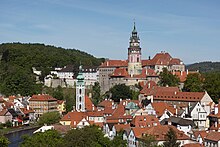
Architectural heritage is an object of interest to visitors – it includes
Away from the towns, areas such as Bohemian Paradise, Bohemian Forest and the Giant Mountains attract visitors seeking outdoor pursuits.
The country is also known for its various
in the country.Science
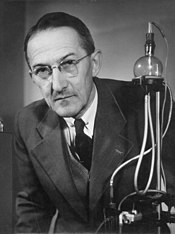
The Czech lands have a long and well-documented history of scientific innovation.
Historically, the Czech lands, especially

Historically, most scientific research was recorded in Latin, but from the 18th century onwards increasingly in German and later in Czech, archived in libraries supported and managed by religious groups and other denominations as evidenced by historical locations of international renown and heritage such as the Strahov Monastery and the Clementinum in Prague. Increasingly, Czech scientists publish their work and that of their history in English.[181][182]
The current important scientific institution is the already mentioned Academy of Sciences of the Czech Republic, the CEITEC Institute in Brno or the HiLASE and Eli Beamlines centers with the most powerful laser in the world in Dolní Břežany. Prague is the seat of the administrative center of the GSA Agency operating the European navigation system Galileo and the European Union Agency for the Space Programme.
Demographics
The
According to results of the 2021 census, the majority of the inhabitants of the Czech Republic are
There were 658,564 foreigners residing in the country in 2021,[193] according to the Czech Statistical Office, with the largest groups being Ukrainian (22%), Slovak (22%), Vietnamese (12%), Russian (7%) and German (4%). Most of the foreign population lives in Prague (37.3%) and Central Bohemia Region (13.2%).[194]
The
Nationality of residents, who answered the question in the Census 2021:[198][199]
| Nationality | Share |
|---|---|
| Czech | 83.76% |
| Moravian | 4.99% |
| Czech and Moravian | 2.50% |
| Slovak | 1.33% |
| Ukrainian | 1.08% |
| Czech and Slovak | 0.82% |
| Vietnamese | 0.44% |
| Polish | 0.37% |
| Russian | 0.35% |
| Other | 4.36% |
Largest cities
| Rank | Name
|
Region | Pop. | Rank | Name
|
Region | Pop. | ||
|---|---|---|---|---|---|---|---|---|---|
 Prague  Brno |
1 | Prague | Prague | 1,357,326 | 11 | Zlín | Zlín | 74,191 |  Ostrava  Plzeň |
| 2 | Brno | South Moravian | 396,101 | 12 | Havířov | Moravian-Silesian | 70,245 | ||
| 3 | Ostrava | Moravian-Silesian | 283,504 | 13 | Kladno | Central Bohemian | 68,436 | ||
| 4 | Plzeň | Plzeň | 181,240 | 14 | Most | Ústí nad Labem | 63,856 | ||
| 5 | Liberec | Liberec | 107,389 | 15 | Opava | Moravian-Silesian | 55,512 | ||
| 6 | Olomouc | Olomouc | 101,825 | 16 | Frýdek-Místek | Moravian-Silesian | 54,188 | ||
| 7 | České Budějovice | South Bohemian | 96,417 | 17 | Jihlava | Vysočina | 52,548 | ||
| 8 | Hradec Králové | Hradec Králové | 93,506 | 18 | Teplice | Ústí nad Labem | 50,843 | ||
| 9 | Pardubice | Pardubice | 92,149 | 19 | Karviná | Moravian-Silesian | 50,172 | ||
| 10 | Ústí nad Labem | Ústí nad Labem | 91,963 | 20 | Karlovy Vary | Karlovy Vary | 49,043 | ||
Religion
| Religion in the Czech Republic (2011)[201] | ||||
|---|---|---|---|---|
| Undeclared | 44.7% | |||
| Irreligion | 34.5% | |||
| Catholicism | 10.5% | |||
| Believers, not members of other religions | 6.8% | |||
| Other Christian churches | 1.1% | |||
| Protestantism | 1% | |||
| Believers, members of other religions | 0.7% | |||
| Other religions / Unknown | 0.7% | |||
About 75%
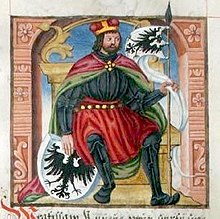
Christianization in the 9th and 10th centuries introduced
According to the 2011 census, 34% of the population stated they had no religion, 10.3% was Catholic, 0.8% was
The proportion of religious believers varies significantly across the country, from 55% in Zlín Region to 16% in Ústí nad Labem Region.[211]
Education and health care

Education in the Czech Republic is compulsory for nine years and citizens have access to a
The Programme for International Student Assessment, coordinated by the OECD, currently ranks the Czech education system as the 15th most successful in the world, higher than the OECD average.[213] The UN Education Index ranks the Czech Republic 10th as of 2013[update] (positioned behind Denmark and ahead of South Korea).[214]
Health care in the Czech Republic is similar in quality to that of other developed nations. The Czech
Culture
This section needs additional citations for verification. Please help improve this article by adding citations to reliable sources in this section. Unsourced material may be challenged and removed. (May 2023) (Learn how and when to remove this template message) |
Art
In the first half of the 19th century,
The 20th century brought an avant-garde revolution, represented in the Czech lands mainly by expressionists and cubists: Josef Čapek, Emil Filla, Bohumil Kubišta or Jan Zrzavý. Surrealism emerged particularly through the work of Toyen, Josef Šíma and Karel Teige. In the world, however, the most well-known Czech avant-garde artist might be František Kupka, a pioneer of abstract painting. Illustrators and cartoonists to gain fame in the first half of the 20th century include Josef Lada, Zdeněk Burian or Emil Orlík. Art photography became a new field represented by František Drtikol, Josef Sudek, later Jan Saudek and Josef Koudelka.
The Czech Republic is also known for its individually made, mouth-blown, and decorated Bohemian glass.
Architecture

The earliest preserved stone buildings in Bohemia and Moravia date back to the time of the Christianization in the 9th and 10th centuries. Since the Middle Ages, the Czech lands have been using the same architectural styles as most of Western and Central Europe. The oldest still standing churches were built in the Romanesque style. During the 13th century, it was replaced by the Gothic style. In the 14th century, Emperor Charles IV invited architects from France and Germany, Matthias of Arras and Peter Parler, to his court in Prague. During the Middle Ages, some fortified castles were built by the king and aristocracy, as well as some monasteries.
The Renaissance style penetrated the Bohemian Crown in the late 15th century when the older Gothic style started to be mixed with Renaissance elements. An example of pure Renaissance architecture in Bohemia is the Queen Anne's Summer Palace, which was situated in the garden of Prague Castle. Evidence of the general reception of the Renaissance in Bohemia, involving an influx of Italian architects, can be found in spacious chateaus with arcade courtyards and geometrically arranged gardens.[217] Emphasis was placed on comfort, and buildings that were built for entertainment purposes also appeared.[218]
In the 17th century, the Baroque style spread throughout the Crown of Bohemia.[219]
In the 18th century, Bohemia produced an architectural peculiarity – the Baroque Gothic style, a synthesis of the Gothic and Baroque styles.[217]
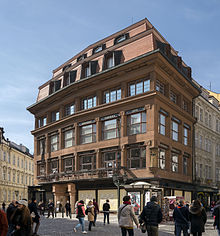
During the 19th century stands the
Bohemia contributed an unusual style to the world's architectural heritage when Czech architects attempted to transpose the Cubism of painting and sculpture into architecture.
Between World Wars I and II, Functionalism, with its sober, progressive forms, took over as the main architectural style.[217]
After World War II and the Communist coup in 1948, art in Czechoslovakia became Soviet-influenced. The Czechoslovak avant-garde artistic movement is known as the
The Czech Republic is not shying away from the more modern trends of international architecture, an example is the
Influential Czech architects include Peter Parler, Benedikt Rejt, Jan Santini Aichel, Kilian Ignaz Dientzenhofer, Josef Fanta, Josef Hlávka, Josef Gočár, Pavel Janák, Jan Kotěra, Věra Machoninová, Karel Prager, Karel Hubáček, Jan Kaplický, Eva Jiřičná or Josef Pleskot.
Literature
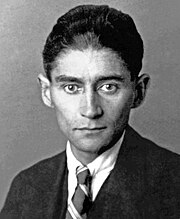
The literature from the area of today's Czech Republic was mostly written in Czech, but also in Latin and German or even Old Church Slavonic. Franz Kafka, although a competent user of Czech, wrote in his mother tongue, German.[220][221] His works include The Trial and The Castle.
In the second half of the 13th century, the royal court in Prague became one of the centers of German Minnesang and courtly literature. The Czech German-language literature can be seen in the first half of the 20th century.
Bible translations played a role in the development of Czech literature. The oldest Czech translation of the Psalms originated in the late 13th century and the first complete Czech translation of the Bible was finished around 1360. The first complete printed Czech Bible was published in 1488. The first complete Czech Bible translation from the original languages was published between 1579 and 1593. The Codex Gigas from the 12th century is the largest extant medieval manuscript in the world.[222]

Czech-language literature can be divided into several periods: the Middle Ages; the Hussite period; the Renaissance humanism; the Baroque period; the Enlightenment and Czech reawakening in the first half of the 19th century, modern literature in the second half of the 19th century; the avant-garde of the interwar period; the years under Communism; and the Czech Republic.
The antiwar comedy novel The Good Soldier Švejk is the most translated Czech book in history.
The international literary award the Franz Kafka Prize is awarded in the Czech Republic.[223]
The Czech Republic has the densest network of libraries in Europe.[224]
Czech literature and culture played a role on at least two occasions when Czechs lived under oppression and political activity was suppressed. On both of these occasions, in the early 19th century and then again in the 1960s, the Czechs used their cultural and literary effort to strive for political freedom, establishing a confident, politically aware nation.[225]
Music
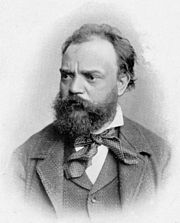
The musical tradition of the Czech lands arose from the first church hymns, whose first evidence is suggested at the break of the 10th and 11th centuries. Some pieces of Czech music include two chorales, which in their time performed the function of anthems: "
The wealth of musical culture lies in the classical music tradition during all historical periods, especially in the
Czech music can be considered to have been "beneficial" in both the European and worldwide context, several times co-determined or even determined a newly arriving era in musical art,
A music festival in the country is Prague Spring International Music Festival of classical music, a permanent showcase for performing artists, symphony orchestras and chamber music ensembles of the world.
Theatre
The roots of Czech theatre can be found in the Middle Ages, especially in the cultural life of the
A drama is Karel Čapek's play R.U.R., which introduced the word "robot".[229]
The country has a tradition of puppet theater. In 2016, Czech and Slovak Puppetry was included on the UNESCO Intangible Cultural Heritage Lists.[230]
Film
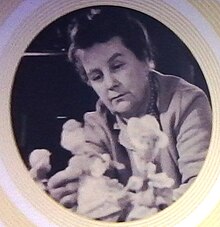
The tradition of Czech cinematography started in the second half of the 1890s. Peaks of the production in the era of silent movies include the historical drama The Builder of the Temple and the social and erotic drama Erotikon directed by Gustav Machatý.[231] The early Czech sound film era was productive, above all in mainstream genres, with the comedies of Martin Frič or Karel Lamač. There were dramatic movies sought internationally.[citation needed]
Hermína Týrlová was a prominent Czech animator, screenwriter, and film director. She was often called the mother of Czech animation. Over the course of her career, she produced over 60 animated children's short films using puppets and the technique of stop motion animation.[citation needed]
Before the German occupation, in 1933, filmmaker and animator Irena Dodalová [cs] established the first Czech animation studio "IRE Film" with her husband Karel Dodal.[citation needed]
After the period of Nazi occupation and early communist official dramaturgy of socialist realism in movies at the turn of the 1940s and 1950s with fewer exceptions such as
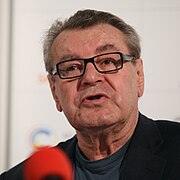
In the 1960s, the hallmark of Czechoslovak New Wave's films were improvised dialogues, black and absurd humor and the occupation of non-actors. Directors are trying to preserve natural atmosphere without refinement and artificial arrangement of scenes. A personality of the 1960s and the beginning of the 1970s with original manuscript and psychological impact is František Vláčil. Another international author is Jan Švankmajer, a filmmaker and artist whose work spans several media. He is a self-labeled surrealist known for animations and features.[233]
The Barrandov Studios in Prague are the largest film studios with film locations in the country.[234] Filmmakers have come to Prague to shoot scenery no longer found in Berlin, Paris and Vienna. The city of Karlovy Vary was used as a location for the 2006 James Bond film Casino Royale.[235]
The
Media

Czech journalists and media enjoy a degree of
The best-selling daily national newspapers in 2020/21 are
Most Czechs (87%
Cuisine
This section needs additional citations for verification. Please help improve this article by adding citations to reliable sources in this section. Unsourced material may be challenged and removed. (July 2023) (Learn how and when to remove this template message) |

Czech cuisine is marked by an emphasis on meat dishes with pork, beef, and chicken. Goose, duck, rabbit, and venison are served. Fish is less common, with the occasional exception of fresh trout and carp, which is served at Christmas.[242][243] One popular Czech menu item is smažený vepřový řízek (fried breaded pork filet), served with boiled potatos.[244]
There is a variety of local sausages, wurst, pâtés, and smoked and cured meats. Czech desserts include a variety of whipped cream, chocolate, and fruit pastries and tarts, crêpes, creme desserts and cheese, poppy-seed-filled and other types of traditional cakes such as buchty, koláče and štrúdl.[245]
The South Moravian region has been producing wine since the Middle Ages; about 94% of vineyards in the Czech Republic are Moravian. Aside from beer, slivovitz and wine, the Czech Republic also produces two liquors, Fernet Stock and Becherovka. Kofola is a non-alcoholic domestic cola soft drink which competes with Coca-Cola and Pepsi.
Sport

The two leading sports in the Czech Republic are football and ice hockey. The most watched sporting events are the Olympic tournament and World Championships of ice hockey.[246][247] Other most popular sports include tennis, volleyball, floorball, golf, ball hockey, athletics, basketball and skiing.[248]
The country has won 15 gold medals in the
The Škoda Motorsport is engaged in competition racing since 1901 and has gained a number of titles with various vehicles around the world. MTX automobile company was formerly engaged in the manufacture of racing and formula cars since 1969.[citation needed]
Hiking is a popular sport. The word for 'tourist' in Czech, turista, also means 'trekker' or 'hiker'. For hikers, thanks to the more than 120-year-old tradition, there is the Czech Hiking Markers System of trail blazing, that has been adopted by countries worldwide. There is a network of around 40,000 km of marked short- and long-distance trails crossing the whole country and all the Czech mountains.[249][250]
See also
- List of Czech Republic-related topics
- Outline of the Czech Republic
Notes
References
Citations
- ^ "Czech language". Czech Republic – Official website. Ministry of Foreign Affairs of the Czech Republic. Archived from the original on 6 November 2011. Retrieved 14 November 2011.
- ^ a b c "Národnost". Census 2021 (in Czech). Czech Statistical Office. Archived from the original on 15 January 2022. Retrieved 13 January 2022.
- ^ "Náboženská víra". Census 2021 (in Czech). Czech Statistical Office. Archived from the original on 22 January 2022. Retrieved 13 January 2022.
- ^ a b "Land use (as at 31 December)". Public database. Czech Statistical Office. Retrieved 11 May 2023.
- ^ "Population – CZSO". Czech Statistical Office. 23 March 2024.
- ^ a b c d "World Economic Outlook Database, October 2023 Edition. (Czechia)". IMF.org. International Monetary Fund. 10 October 2023. Retrieved 11 October 2023.
- ^ "Gini coefficient of equivalised disposable income". Eurostat. Archived from the original on 9 October 2020. Retrieved 21 June 2022.
- ^ "Human Development Report 2023/24" (PDF). United Nations Development Programme. 13 March 2024. Retrieved 13 March 2024.
- ^ Citizens belonging to minorities, which traditionally and on a long-term basis live within the territory of the Czech Republic, enjoy the right to use their language in communication with authorities and in courts of law (for the list of recognized minorities see National Minorities Policy of the Government of the Czech Republic Archived 7 June 2012 at the Wayback Machine, Belarusian and Vietnamese since 4 July 2013, see Česko má nové oficiální národnostní menšiny. Vietnamce a Bělorusy Archived 8 July 2013 at the Wayback Machine). Article 25 of the Czech Charter of Fundamental Rights and Freedoms ensures the right of the national and ethnic minorities to education and communication with the authorities in their own language. Act No. 500/2004 Coll. (The Administrative Rule) in its paragraph 16 (4) (Procedural Language) ensures that a citizen of the Czech Republic who belongs to a national or an ethnic minority, which traditionally and on a long-term basis lives within the territory of the Czech Republic, has the right to address an administrative agency and proceed before it in the language of the minority. If the administrative agency has no employee with knowledge of the language, the agency is bound to obtain a translator at the agency's own expense. According to Act No. 273/2001 (Concerning the Rights of Members of Minorities) paragraph 9 (The right to use language of a national minority in dealing with authorities and in front of the courts of law) the same also applies to members of national minorities in the courts of law.
- ^ The Slovak language may be considered an official language in the Czech Republic under certain circumstances, as defined by several laws – e.g. law 500/2004, 337/1992. Source: http://portal.gov.cz Archived 10 April 2005 at the Wayback Machine. Cited: "Například Správní řád (zákon č. 500/2004 Sb.) stanovuje: "V řízení se jedná a písemnosti se vyhotovují v českém jazyce. Účastníci řízení mohou jednat a písemnosti mohou být předkládány i v jazyce slovenském ..." (§ 16, odstavec 1). Zákon o správě daní a poplatků (337/1992 Sb.) "Úřední jazyk: Před správcem daně se jedná v jazyce českém nebo slovenském. Veškerá písemná podání se předkládají v češtině nebo slovenštině ..." (§ 3, odstavec 1). http://portal.gov.cz
- ^ "Oxford English Dictionary". Archived from the original on 11 January 2008. Retrieved 13 September 2014.
- ^ "Publications Office — Interinstitutional style guide — 7.1. Countries — 7.1.1. Designations and abbreviations to use". Publications Office. Archived from the original on 12 April 2023. Retrieved 13 October 2023.
- ^ "the Czech Republic". The United Nations Terminology Database. Archived from the original on 16 June 2023. Retrieved 28 November 2023.
- ^ Šitler, Jiří (12 July 2016). "From Bohemia to Czechia". Czech Radio. Retrieved 1 June 2021.
- ^ "Information about the Czech Republic". Czech Foreign Ministry. Archived from the original on 3 April 2016. Retrieved 25 March 2016.
- ^ Mlsna, Petr; Šlehofer, F.; Urban, D. (2010). "The Path of Czech Constitutionality" (PDF). 1st edition (in Czech and English). Praha: Úřad Vlády České Republiky (The Office of the Government of the Czech Republic). pp. 10–11. Archived (PDF) from the original on 16 January 2013. Retrieved 31 October 2012.
- ^ Čumlivski, Denko (2012). "800 let Zlaté buly sicilské" (in Czech). National Archives of the Czech Republic (Národní Archiv České Republiky). Archived from the original on 28 November 2012. Retrieved 31 October 2012.
- ISBN 978-1135923112. Archivedfrom the original on 22 November 2018. Retrieved 13 December 2017.
- ISBN 0-14-014038-7p. 60
- ^ "Czech definition and meaning". Collins English Dictionary. Collins. Archived from the original on 16 January 2013. Retrieved 19 November 2012.
- American Heritage Dictionary. Houghton Mifflin Harcourt. Retrieved 24 January 2018.
- ^ "Czech – Definition in English". Oxford Dictionaries. Oxford University Press. Archived from the original on 12 April 2018. Retrieved 11 April 2018.
- ^ Spal, Jaromír. "Původ jména Čech". Naše řeč. Archived from the original on 9 December 2012. Retrieved 10 December 2012.
- ^ Sviták, Zbyněk (2014). "Úvod do historické topografie českých zemí: Územní vývoj českých zemí" (PDF). 1st edition (in Czech). Brno. pp. 75–80, 82, 92–96. Archived (PDF) from the original on 9 December 2017. Retrieved 23 June 2021.
- ^ "From Bohemia to Czechia – Radio Prague". 12 July 2016. Archived from the original on 9 March 2018. Retrieved 11 February 2018.
- ISBN 978-1-61048-892-1.
- ^ "Czechia – the civic initiative". www.czechia-initiative.com. Retrieved 11 January 2022.
- ^ "Vláda schválila doplnení jednoslovného názvu Cesko v cizích jazycích do databází OSN" [The government has approved the addition of one-word Czech name in foreign languages to UN databases]. Ministerstvo zahraničních věcí České republiky (in Czech). 5 May 2016. Archived from the original on 28 August 2018. Retrieved 28 August 2018.
- ^ UNGEGN. "UNGEGN List of Country Names" (PDF). p. 27. Archived (PDF) from the original on 25 July 2018.
- ^ European Union (5 July 2016). "Czechia". European Union. Archived from the original on 25 December 2018. Retrieved 31 May 2021.
- ^ NATO. "Member countries". NATO. Retrieved 3 October 2022.
- ^ "Czechia". The World Factbook (2024 ed.). Central Intelligence Agency. Retrieved 31 May 2021. (Archived 2021 edition.)
- ^ "Czechia: mapping progress one year on". Radio Prague International. 8 June 2017. Retrieved 31 May 2021.
- ^ "Our Members". European Broadcasting Union. 17 February 2023. Retrieved 29 May 2023.
- ^ @APStylebook (1 July 2022). "We have a new Stylebook Online entry: Czechia, the Czech Republic.Both are acceptable. The shorter name Czechia is…" (Tweet) – via Twitter.
- ^ "Top items – Head of a Celt". Muzeum 3000.
- ISBN 978-1-134-74722-1.
- ISBN 978-80-7011-468-1.
- ISBN 978-1-4073-0159-4.
- ISBN 978-0-8179-4492-6.
- ^ ISBN 978-3-8471-0254-0.
- ISBN 978-0-86516-444-4.
- ISBN 978-1-134-80679-9.
- ISBN 978-0-664-22416-5.
- ISBN 978-80-246-2227-9.
- ISBN 978-80-246-2227-9.
- ISBN 978-80-246-2227-9.
- ISBN 978-0-8135-1304-1. Retrieved 26 August 2017.
- ^ "Václav II. český král". panovnici.cz. Archived from the original on 7 September 2011. Retrieved 31 October 2011.
- ^ "Mentor and precursor of the Reformation". Archived from the original on 4 April 2016. Retrieved 29 April 2016.
- ^ "Protestantism in Bohemia and Moravia (Czech Republic)". Virtual Museum of Protestantism. Archived from the original on 15 October 2015. Retrieved 25 May 2015.
- ISBN 80-224-0852-2
- ^ "RP's History Online – Habsburgs". Archiv.radio.cz. Archived from the original on 17 July 2011. Retrieved 25 April 2010.
- ISBN 1-4021-7772-0
- ISBN 0-521-04544-4
- ISBN 0-521-08710-4
- ^ Hlavačka, Milan (2009). "Formování moderního českého národa 1815–1914". Historický Obzor (in Czech). 20 (9/10): 195.
- ^ a b Cole, Laurence; Unowsky, David (eds.). The Limits of Loyalty: Imperial Symbolism, Popular Allegiances, and State Patriotism in the Late Habsburg Monarchy (PDF). New York, Oxford: Berghahn Books. Archived from the original (PDF) on 25 May 2015. Retrieved 24 May 2015.
- ^ "Františka Plamínková: the feminist suffragette who ensured Czechoslovakia's Constitution of 1920 lived up to the principle of equality". Radio Prague International. 29 February 2020. Retrieved 5 January 2021.
- ^ a b Stephen J. Lee. Aspects of European History 1789–1980. Page 107. Chapter "Austria-Hungary and the successor states". Routledge. 28 January 2008.
- ISBN 978-80-87173-47-3, pages 22–81, 85–86, 111–112, 124–125, 128, 129, 132, 140–148, 184–209.
- ^ "Tab. 3 Národnost československých státních příslušníků podle žup a zemí k 15 February 1921" (PDF) (in Czech). Czech Statistical Office. Archived from the original (PDF) on 5 June 2007. Retrieved 2 June 2007.
- ^ "Ekonomika ČSSR v letech padesátých a šedesátých". Blisty.cz. 21 August 1968. Archived from the original on 7 July 2014. Retrieved 14 May 2014.
- ISBN 978-1135923112. Archivedfrom the original on 22 November 2018. Retrieved 13 December 2017.
- ISBN 978-1-349-65611-0.
- ISBN 0465002390
- ISBN 1-4051-3560-3
- ^ Chad Bryant (2009) Prague in Black: Nazi Rule and Czech Nationalism (Harvard University Press, 2009), 208–252.
- ^ F. Čapka: Dějiny zemí Koruny české v datech Archived 20 June 2008 at the Wayback Machine. XII. Od lidově demokratického po socialistické Československo – pokračování. Libri.cz (in Czech)
- ^ "Czech schools revisit communism". Archived from the original on 4 August 2014. Retrieved 13 September 2014.
- ^ Velinger, Jan (28 February 2006). "World Bank Marks Czech Republic's Graduation to 'Developed' Status". Radio Prague. Archived from the original on 12 January 2008. Retrieved 22 January 2007.
- ^ "Human Development Report 2009" (PDF). UNDP.org. January 2009. Archived (PDF) from the original on 22 November 2009. Retrieved 25 April 2010.
- ^ "EU, NATO, Schengen and Eurozone member states in Europe". 13 October 2018.
- ^ "Czech election: Billionaire Babis wins by large margin". BBC News. 21 October 2017.
- ^ "Czech billionaire Andrej Babis named new prime minister". Deutsche Welle. 6 December 2017.
- ^ "Czech Republic: Petr Fiala named new prime minister". DW.COM. 28 November 2021.
- ^ "Retired general Petr Pavel wins election to become Czech president". euronews. 28 January 2023.
- ^ "Regional Refugee Response Plan for the Ukraine Situation – Inter-Agency Operational Update: Czech Republic, July – October 2022". reliefweb. UN Office for the Coordination of Humanitarian Affairs. 17 November 2022. Retrieved 25 February 2023.
- ^ Field, Matt. "Ukraine is fighting on behalf of all democracies". GOV.UK. British Embassy Prague. Retrieved 25 February 2023.
- PMID 28608869.
- ISBN 80-244-1626-3, graphs 1.5 and 1.6
- ^ "Czech absolute record temperature registered near Prague". České noviny. ČTK. Archived from the original on 25 October 2012. Retrieved 20 August 2012.
- ISBN 80-244-1626-3, graph 2.9.
- S2CID 126348854.
- .
- ^ "Country Rankings". Yale. 2016. Archived from the original on 2 February 2016. Retrieved 21 November 2016.
- PMID 33293507.
- ^ "The Constitution of the Czech Republic – Article 16". Czech Republic. Archived from the original on 3 September 2015. Retrieved 8 August 2015.
- ^ "Klaus signs Czech direct presidential election implementing law". Czech Press Agency. 1 August 2012. Archived from the original on 16 January 2013. Retrieved 7 November 2012.
- .
- ^ "Members of the Government". Government of the Czech Republic. Archived from the original on 31 August 2015. Retrieved 8 August 2015.
- ^ "Prime Minister". Government of the Czech Republic. Archived from the original on 4 March 2016. Retrieved 8 August 2015.
- ISBN 978-0-7391-6733-5.
- ^ ISBN 978-80-246-2860-8.
- ^ "Global Peace Index 2020" (PDF). visionofhumanity.org. Institute for Economics and Peace. Archived (PDF) from the original on 9 October 2022.
- United States State Department. Retrieved 8 August 2015.
- ^ "The Henley & Partners Visa Restrictions Index 2018. Data accurate as of 16 January 2018" (PDF). Archived (PDF) from the original on 9 May 2018. Retrieved 13 March 2018.
- ^ "Visa Openness Report 2016" (PDF). World Tourism Organization. Archived from the original (PDF) on 23 January 2016. Retrieved 17 January 2016.
- ^ "About the Visegrad Group". Visegrád Group. 15 August 2006. Archived from the original on 17 July 2015. Retrieved 8 August 2015.
- ^ "Společné prohlášení ke strategickému dialogu mezi Ministerstvem zahraničních věcí České republiky a Ministerstvem zahraničních věcí Spolkové republiky Německo jako novém rámci pro česko-německé vztahy" (PDF). German embassy in the Czech Republic. Archived from the original (PDF) on 3 September 2015. Retrieved 8 August 2015.
- ^ "Czech Vote Against Palestine: Only European Nation At UN To Vote Against Palestinian State Was Czech Republic". The Huffington Post. 30 November 2012. Archived from the original on 24 September 2015. Retrieved 8 August 2015.
- Ministry of Foreign Affairs of the Czech Republic. Archivedfrom the original on 15 October 2015. Retrieved 8 August 2015.
- ^ "Programové prohlášení vlády". Vlada.cz (in Czech). Retrieved 30 March 2023.
- ^ "Rusko zveřejnilo seznam nepřátelských zemí. Jsou na něm jen dvě: Česko a USA" (in Czech). Aktuálně.cz. 14 May 2021. Retrieved 30 March 2023.
- ^ "Czechs with few mates". The Economist. 30 August 2007. Archived from the original on 25 September 2009. Retrieved 8 August 2015.
- ^ "Resortní rozpočet". Ministry of Defence of the Czech Republic. Archived from the original on 2 August 2015. Retrieved 8 August 2015.
- ^ "Foreign Operations". Ministry of Defence of the Czech Republic. Archived from the original on 6 March 2016. Retrieved 25 March 2016.
- ^ "Diskriminace Romů v českých školách jako evropský problém". 1 April 2016. Archived from the original on 1 April 2016. Retrieved 15 November 2022.
- ^ "Evropská komise žádá Česko o data kvůli diskriminaci Romů ve školách". iDNES.cz (in Czech). 25 September 2014. Retrieved 15 November 2022.
- ^ "Evropský soud tlačí vládu k odškodnění za nedobrovolné sterilizace romských žen". llp.cz. Liga lidských práv. 2 April 2016. Archived from the original on 2 April 2016. Retrieved 15 November 2022.
- ^ "Vláda: Litujeme nezákonných sterilizací romských žen". Lidovky.cz (in Czech). 23 November 2009. Retrieved 15 November 2022.
- ^ "Launch of RFE broadcasts from Prague recalled on 20th anniversary". Radio Prague International. 1 July 2015. Retrieved 30 March 2023.
- ^ Lopatka, Jan; Hovet, Jason. "Czech lawmakers give first nod to same-sex marriage bill, opposition ahead". Reuters. Retrieved 19 August 2023.
- ^ "The death of the districts". 3 January 2003. Archived from the original on 15 February 2010. Retrieved 13 September 2014.
- ^ Mccanndigital.cz. "Getting to know Czech Republic". Archived from the original on 19 July 2014. Retrieved 13 September 2014.
- ^ "World Bank 2007". Web.worldbank.org. Archived from the original on 24 May 2008. Retrieved 25 April 2010.
- .
- ^ "GDP per capita in PPS". Eurostat. Archived from the original on 24 May 2015. Retrieved 16 June 2015.
- ^ Tait, Robert (6 January 2019). "Czech democracy 'under threat' from rising debt crisis". The Guardian.
- ^ "World Economic Outlook Database, April 2019". IMF.org. International Monetary Fund. Retrieved 4 June 2019.
- ^ "World Economic Outlook Database, April 2019". IMF.org. International Monetary Fund. Retrieved 24 April 2019.
- ^ Brandmeir, Kathrin; Grimm, Michaela; Heise, Michael; Holzhausen, Arne. "Allianz Global Wealth Report 2018" (PDF). Archived (PDF) from the original on 9 October 2022. Retrieved 25 January 2021.
- ^ "Česká ekonomika na konci roku dál rostla, HDP loni stoupl o 4,5 procenta". iDNES.cz (in Czech). 16 February 2018. Archived from the original on 15 March 2018. Retrieved 14 March 2018.
- ^ Unemployment rates, seasonally adjusted, September 2016 Archived 28 December 2017 at the Wayback Machine. Eurostat.
- ^ Federica Cocco. Israel and the US have the highest poverty rates in the developed world Archived 28 December 2017 at the Wayback Machine. Financial Times. Published on 19 October 2016.
- ^ "Country Rankings: World & Global Economy Rankings on Economic Freedom". www.heritage.org. Archived from the original on 24 November 2018. Retrieved 15 March 2018.
- . Retrieved 23 October 2023.
- ^ "The Global Innovation Index 2016". The Global Innovation Index. 2016. Archived from the original on 2 February 2017. Retrieved 31 January 2019.
- ^ "The Global Competitiveness Report 2018". Archived from the original on 17 October 2018. Retrieved 17 October 2018.
- ^ "Enabling Trade rankings". Archived from the original on 21 March 2018. Retrieved 15 March 2018.
- ^ Economic Complexity Rankings (ECI) Archived 14 March 2018 at the Wayback Machine. The Atlas of Economic Complexity. Access date 3 October 2017.
- ^ LABOR FORCE – BY OCCUPATION Archived 22 May 2014 at the Wayback Machine. The World Factbook.
- ^ "Czech foreign owned companies take second biggest dividend yield in 2017:report". Radio Prague. 7 March 2018.
- ^ "Czech Republic to join Schengen". The Prague Post. 13 December 2006. Archived from the original on 25 February 2008. Retrieved 8 October 2007.
- ^ "100 Nejvýznamnějších". CZECH TOP 100 (in Czech). Retrieved 1 July 2019.
- ^ "Tramvaje firmy Pragoimex: česká klasika v novém kabátě". Euro.cz (in Czech). 16 December 2008. Archived from the original on 14 April 2018. Retrieved 13 April 2018.
- ^ "Zlaté české ručičky. V tomhle jsme nejlepší, i když se o tom skoro neví". ČtiDoma.cz (in Czech). 11 April 2018. Archived from the original on 13 April 2018. Retrieved 13 April 2018.
- ^ "Příběh firmy Česká zbrojovka: kde se rodí pistole". E15.cz.
- ^ "'V lednu ani kubík.' Dovoz plynu z Ruska do Česka klesl na nulu, uvedl Síkela". iROZHLAS (in Czech). 18 February 2023. Retrieved 30 March 2023.
- ^ "Transport Yearbook 2020: 3.2.1. Road transport infrastructure". Ministry of Transport. Retrieved 24 November 2021.
- ^ "Going abroad – Czech Republic". ec.europa.eu. Archived from the original on 3 October 2018. Retrieved 3 October 2018.
- ^ "Transport Yearbook 2020: 3.1.2. Lines". Ministry of Transport. Retrieved 24 November 2021.
- ^ "Transport Yearbook 2020: 3.1.1. Tracks". Ministry of Transport. Retrieved 24 November 2021.
- ^ "Letiště" (in Czech). Ministry of Transport. Retrieved 24 November 2021.
- ^ "Transport Yearbook 2020: 3.4. Air transport infrastructure". Ministry of Transport. Retrieved 24 November 2021.
- ^ "Letišť má Česko až moc, většinou jsou ztrátová" (in Czech). Novinky.cz. 21 August 2019. Retrieved 24 November 2021.
- ^ Vlček, Pavel (14 November 2010). "Minister Kocourek launches the Gazela gas pipeline linking the Czech Republic to Nord Stream". Ministry of Industry and Trade. Retrieved 15 January 2019.
- ^ Taylor, Lee (2 May 2012). "'State of the Internet' report reveals the fastest web speeds around the world". news.com.au. Archived from the original on 2 May 2012. Retrieved 2 May 2012.
- ^ "Wi-Fi: Poskytovatelé bezdrátového připojení". internetprovsechny.cz. Archived from the original on 8 March 2008. Retrieved 17 March 2008.
- ^ "Bezdrátové připojení k internetu". bezdratovepripojeni.cz. Archived from the original on 23 June 2008. Retrieved 18 May 2008.
- ^ "Antivirus giant Avast is acquiring rival AVG for $1.3b". TNW. 7 July 2016. Archived from the original on 12 June 2018. Retrieved 18 June 2018.
- ^ "Avast not done with deal-making after AVG buy, but no rush". Reuters. 30 September 2016. Archived from the original on 16 October 2017. Retrieved 2 July 2017.
- ^ "Avast Buys Piriform, the Company Behind CCleaner and Recuva". BleepingComputer. Archived from the original on 20 July 2017. Retrieved 5 March 2018.
- ^ Bremner, Caroline (2015). "Top 100 City Destinations Ranking". Euromonitor International. Archived from the original on 28 June 2015. Retrieved 9 February 2015.
- ^ "Promotion Strategy of the Czech Republic in 2004–2010". Czech Tourism. Archived from the original on 28 March 2007. Retrieved 19 December 2006.
- ^ "Prague sees significant dip in tourist numbers". Radio.cz. 21 April 2010. Archived from the original on 3 April 2009. Retrieved 25 April 2010.
- ^ a b "Prague mayor goes undercover to expose the great taxi rip-off". The Independent. Archived from the original on 5 September 2011. Retrieved 13 September 2014.
- ^ "Tips on Staying Safe in Prague". Archived from the original on 23 September 2014. Retrieved 13 September 2014.
- ^ "Czech Republic – Country Specific Information". Archived from the original on 17 December 2013. Retrieved 13 September 2014.
- ^ "Tentative Lists". UNESCO. Retrieved 13 March 2024.
- ^ "Czech Republic Travel Guide – Tourist Information and Guide to Czech Republic". www.travelguidepro.com. Archived from the original on 23 August 2018. Retrieved 10 January 2018.
- ^ "Czech Science: Past, Present, and Future". connect.ceitec.cz/. Ceitec Connect. Retrieved 1 June 2021.
- ^ "Czech Footprint: Inventions and Inventors". www.skoda-storyboard.com/. 16 November 2018. Retrieved 1 June 2021.
- ^ "National Artificial Intelligence Strategy of the Czech Republic" (PDF). www.mpo.cz. Ministry of Industry and Trade. Archived (PDF) from the original on 9 October 2022. Retrieved 1 June 2021.
- ^ "Research and Development in the Czech Republic". www.czechinvest.org/en. Czech Invest. Retrieved 1 June 2021.
- ^ "Best Global Universities in the Czech Republic". www.usnews.com. U.S. News & World Report. Retrieved 1 June 2021.
- ^ "Research News". gacr.cz/en. Grantová agentura České republiky. Retrieved 1 June 2021.
- ^ "Exhibition traces Czech contribution to finding Amazon River source". www.czech.radio. Radio Prague International. 28 May 2021. Retrieved 1 June 2021.
- ^ "The Czech Republic, home of robotics". ec.europa.eu. 19 June 2012. Retrieved 1 June 2021.
- ^ "World success of Czech scientists: A breakthrough method can help in the treatment of Alzheimer's disease or cancer". imtm.cz. Institute of Molecular and Translational Medicine. Archived from the original on 2 June 2021. Retrieved 1 June 2021.
- ^ "Czech and Slovak Freedom Lecture: The Role of Czech and International Scientists in the Fight Against the Pandemic". www.wilsoncenter.org. The Wilson Center. Retrieved 1 June 2021.
- ^ "Global Innovation Index 2021". World Intellectual Property Organization. United Nations. Retrieved 5 March 2022.
- ^ "Release of the Global Innovation Index 2020: Who Will Finance Innovation?". wipo.int. Retrieved 2 September 2021.
- ^ "Global Innovation Index 2019". wipo.int. Retrieved 2 September 2021.
- ^ "The Czech Academy of Sciences". www.avcr.cz. The Czech Academy of Sciences. Retrieved 1 June 2021.
- ^ "Czech Made". www.czech.radio. Radio Prague International. 19 January 2021. Retrieved 1 June 2021.
- ^ "Czechoslovak Society of Arts & Sciences". svu2000.org. Společnost pro vědy a umění. Retrieved 1 June 2021.
- ^ "All Nobel Prizes". NobelPrize.org. Retrieved 2 June 2021.
- ^ "Sigmund Freud | Biography, Theories, Works, & Facts". Encyclopedia Britannica. Retrieved 2 June 2021.
- OCLC 857364787.
- S2CID 196613980.
- ^ "Research and Innovation Ranking". www.scimagoir.com. Scimago Institutions Rankings. Retrieved 1 June 2021.
- ^ "Population change – year 2015". Population change – year 2015.
- ^ "The World FactBook – Czechia", The World Factbook, 18 November 2021
- ^ "Czechia". The World Factbook (2024 ed.). Central Intelligence Agency. Retrieved 14 May 2014. (Archived 2014 edition.)
- ^ "Press: Number of foreigners in ČR up ten times since 1989". Prague Monitor. 11 November 2009.
- ^ O'Connor, Coilin (29 May 2007). "Is the Czech Republic's Vietnamese community finally starting to feel at home?". Czech Radio. Archived from the original on 13 January 2008. Retrieved 1 February 2008.
- ^ Bilefsky, Dan (6 June 2009). "Crisis Strands Vietnamese Workers in a Czech Limbo". The New York Times. Archived from the original on 25 March 2014. Retrieved 13 September 2014.
- ^ "Foreigners working in the Czech Republic". Ministry of Foreign Affairs. July 2006. Archived from the original on 3 June 2009. Retrieved 3 June 2009.
- ^ "The History and Origin of the Roma". Romove.radio.cz. Archived from the original on 25 April 2010. Retrieved 25 April 2010.
- ^ Green, Peter S. (5 August 2001). "British Immigration Aides Accused of Bias by Gypsies". The New York Times. Archived from the original on 11 November 2012. Retrieved 25 April 2010.
- ^ "Jarosław Jot-Drużycki: Poles living in Zaolzie identify themselves better with Czechs Archived 26 April 2018 at the Wayback Machine". European Foundation of Human Rights. 3 September 2014.
- ^ "R01 Cizinci v ČR v letech 2004 – 2021 (stav k 31. 12.)". Czech Statistical Office. Retrieved 21 March 2023.
- ISBN 978-80-250-2781-3.
- ^ "The Holocaust in Bohemia and Moravia". Ushmm.org. Archived from the original on 5 August 2009. Retrieved 25 April 2010.
- ^ "The Virtual Jewish Library". Archived from the original on 21 June 2010. Retrieved 13 September 2014.
- ^ "PM Fischer visits Israel Archived 25 July 2009 at the Wayback Machine". Radio Prague. 22 July 2009.
- ^ "První výsledky Sčítání 2021" (PDF). Czech Statistical Office. Archived (PDF) from the original on 9 October 2022. Retrieved 13 January 2022.
- ^ "Všechny tabulky - sldb2021_pv_tabulky.xlsx". Czech Statistical Office. Retrieved 13 January 2022.
- ^ "Population of Municipalities – 1 January 2023". Czech Statistical Office. 23 May 2023.
- ^ a b "Population by religious belief and by municipality size groups" (PDF). Czech Statistical Office. Archived from the original (PDF) on 21 February 2015. Retrieved 23 April 2012.
- ^ "End of year 2014 – Czech Republic" (PDF). Wingia.com. Archived from the original (PDF) on 9 March 2017. Retrieved 5 January 2018.
- ^ "NÁBOŽENSKÁ VÍRA OBYVATEL PODLE VÝSLEDKŮ SČÍTÁNÍ LIDU". Czech Statistical Office. 27 February 2014. Archived from the original on 13 May 2018. Retrieved 27 December 2017.
Chapter 1. "Změny struktury obyvatel podle náboženské víry v letech 1991, 2001 a 2011"; table "Struktura obyvatel podle náboženské víry (náboženského vyznání) v letech 1991 – 2011": believers 20,8%; non-believers 34,5%; no declared religion 44,7%
- ^ Global Index of Religion and Atheism Archived 26 December 2017 at the Wayback Machine Press Release Archived 21 October 2013 at the Wayback Machine. 2012. secularpolicyinstitute.net
- ^ Richard Felix Staar, Communist regimes in Eastern Europe, Issue 269, p. 90
- doi:10.13060/00380288.2002.38.3.06. Archived from the original(PDF) on 1 November 2021.
- ^ "Czechia". World Jewish Congress. Retrieved 16 May 2022.
- ^ The Czechoslovak Hussite Church contains mixed Protestant, Catholic, Eastern Orthodox and national elements. Classifying it as either one is disputable. For more details and dispute about this, see Czechoslovak Hussite Church.
- ^ "Population by denomination and sex: as measured by 1921, 1930, 1950, 1991 and 2001 censuses" (PDF) (in Czech and English). Czech Statistical Office. Archived (PDF) from the original on 21 February 2011. Retrieved 9 March 2010.
- ^ "Europe's Growing Muslim Population". Pew Research Center. 29 November 2017. Retrieved 16 May 2022.
- ^ "Data za poměrové ukazatele – sldb2021". Czech Statistical Office. Retrieved 13 January 2022.
- ^ from the original on 24 November 2016.
- ^ "Range of rank on the PISA 2006 science scale" (PDF). OECD.org. Archived (PDF) from the original on 29 December 2009. Retrieved 25 April 2010.
- ^ "Education index | Human Development Reports". hdr.undp.org. Archived from the original on 4 January 2018.
- PMID 16902697.
- ^ "Euro Health Consumer Index 2016" (PDF). Health Consumer Powerhouse. Archived from the original (PDF) on 14 October 2017. Retrieved 8 April 2017.
- ^ a b c d "History of Czech Architecture". eu2009.cz. Czech Presidency of the European Union. Archived from the original on 15 October 2015. Retrieved 20 July 2015.
- ^ "The History of Architecture". www.czech.cz. Archived from the original on 23 September 2015. Retrieved 18 August 2015.
- ISBN 978-80-86161-38-9.
- ^ Hawes 2008, p. 29.
- ^ Sayer 1996, pp. 164–210.
- ^ "Codex Gigas: The Devil's Bible". Prague Post. 19 October 2005. Retrieved 5 January 2021.
- ^ "Společnost Franze Kafky – Cena Franze Kafky". www.franzkafka-soc.cz. Archived from the original on 13 January 2017. Retrieved 9 February 2017.
- ^ Patterson, Dave (21 July 2016). "The Czech Republic Has The Densest Library Network In The World". Archived from the original on 11 February 2017. Retrieved 9 February 2017.
- ISBN 978-0-7425-3024-9.
- ^ The chronicles of Beneš Krabice of Veitmil – the hymn "Svatý Václave" mentioned there as old and well-known at the end of the 13th century [1] Archived 5 March 2012 at the Wayback Machine
- ^ Dějiny české hudby v obrazech (History of Czech music in pictures); in Czech
- ^ "Czech Music". 27 June 2007. Archived from the original on 2 January 2016. Retrieved 3 January 2016.
- ^ "The Origin Of The Word 'Robot'". Science Friday. Retrieved 5 January 2021.
- ^ "Puppetry in Slovakia and Czechia". unesco.org. UNESCO. Retrieved 29 November 2021.
- ^ "Gustav Machatý's Erotikon (1929) & Ekstase (1933): Cinema's Earliest Explorations of Women's Sensuality". Open Culture. Archived from the original on 25 January 2016. Retrieved 8 January 2016.
- ^ "History of Czech cinematography". Archived from the original on 28 January 2016. Retrieved 8 January 2016.
- ^ Solomon, Charles (19 July 1991). "Brooding Cartoons From Jan Svankmajer". LA Times. Archived from the original on 15 July 2012. Retrieved 24 August 2010.
- ^ "KFTV". Wilmington Publishing and Information Ltd. Archived from the original on 16 January 2013. Retrieved 26 October 2012.
- ^ "Czech Film Commission – Karlovy Vary". Czech Film Commission. Archived from the original on 16 January 2013. Retrieved 26 October 2012.
- ^ "2021 World Press Freedom Index". Reporters Without Borders. Retrieved 30 November 2021.
- ^ "Pro ČT byl rok 2020 rokem rekordů, Nova kralovala sledovanosti" (in Czech). iDnes. 5 January 2021. Retrieved 30 November 2021.
- ^ "Kdo vlastní v Česku noviny? Babiš, Křetinský, Bakala a další" (in Czech). Finance.cz. 2 July 2021. Retrieved 30 November 2021.
- ^ "Digital News Report: Češi získávají zprávy z internetu a TV, věří ČT a ČRo". MediaGuru.cz (in Czech). Retrieved 15 January 2022.
- ^ "Digital News Report 2021". Reuters Institute for the Study of Journalism. Retrieved 15 January 2022.
- ^ "Online data (OLA) | SPIR". netmonitor.cz. Retrieved 15 January 2022.
- ^ Purkrábek, Jan (24 December 2020). "Why do Czechs eat carp for Christmas?". Expats.cz. Howlings s.r.o. Retrieved 25 February 2023.
- ^ "Czech Food and Drink". myCzechRepublic. Local Lingo s.r.o. Retrieved 25 February 2023.
- ISBN 978-1-4237-3585-4.
- ^ Čiháková, Jana. "Hledá se skutečně český dezert. Uhádnete, který to je?". CZ TEST. Granville. Retrieved 25 February 2023.
- ^ "ČT sport vysílá deset let, nejsledovanější byl hokej". MediaGuru.cz (in Czech). Archived from the original on 7 May 2018. Retrieved 6 May 2018.
- ^ "Prague's Most Popular Sports". Prague.fm. 21 October 2011. Archived from the original on 13 April 2014. Retrieved 14 May 2014.
- ^ "Golf, florbal a hokejbal pronikly mezi nejoblíbenější české sporty". iDNES.cz. 11 October 2009.
- ^ "Hiking in the Czech Republic". Expats. 16 June 2011. Archived from the original on 23 October 2016. Retrieved 23 October 2016.
- ^ "Turistické značení KČT". KČT. Archived from the original on 15 February 2017. Retrieved 23 October 2016.
General sources
- Angi, János (1997). "A nyugati szláv államok" [Western Slavic states]. In Pósán, László; Papp, Imre; Bárány, Attila; Orosz, István; Angi, János (eds.). Európa a korai középkorban [Europe in the Early Middle Ages] (in Hungarian). Multiplex Media – Debrecen University Press. pp. 358–365. ISBN 978-963-04-9196-9.
- ISBN 978-0-312-37651-2.
- Sayer, Derek (1996). "The Language of Nationality and the Nationality of Language: Prague 1780–1920". Past and Present. 153 (1). Oxford: 164. OCLC 394557. Archived from the originalon 7 April 2020. Retrieved 25 January 2021.
Further reading
- Hochman, Jiří (1998). Historical dictionary of the Czech State. Scarecrow Press. ISBN 0810833387
- Bryant, Chad. Prague: Belonging and the Modern City. Cambridge MA: Harvard University Press, 2021.
External links
- Governmental website
- Presidential website
- Senate
- Portal of the Public Administration
- #VisitCzechia – official tourist portal of the Czech Republic
- Czechia – Central Intelligence Agency: The World Factbook
 Wikimedia Atlas of the Czech Republic
Wikimedia Atlas of the Czech Republic Geographic data related to Czech Republic at OpenStreetMap
Geographic data related to Czech Republic at OpenStreetMap
 Media from Commons
Media from Commons News from Wikinews
News from Wikinews Texts from Wikisource
Texts from Wikisource Travel guides from Wikivoyage
Travel guides from Wikivoyage
Czech Republic articles | |||
|---|---|---|---|
| History | |||
| Geography | |||
| Politics |
| ||
| Economy | |||
| Society | |||
| Culture | |||
| International | |
|---|---|
| National | |
| Geographic | |
| Academics | |
| People | |
| Other | |







